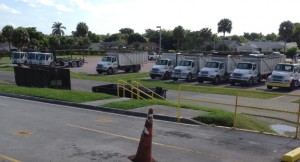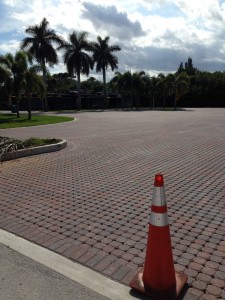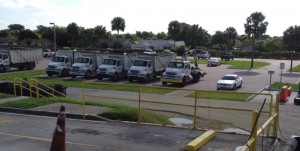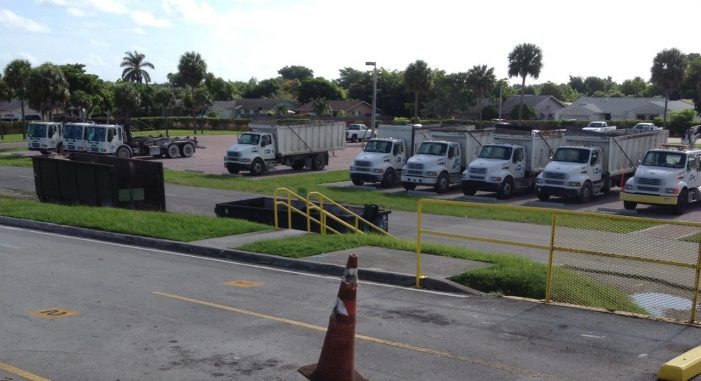While the Miami-Dade Commission considers firing 700 workers and slashing services and  making employees sacrifice their benefits, the county spent close to $1 million this year on fancy new pavers for the parking lots at three county facilities.
making employees sacrifice their benefits, the county spent close to $1 million this year on fancy new pavers for the parking lots at three county facilities.
No, not libraries or neighborhood service agencies or cultural centers where hundreds of constituents come and go. These octagonal, terracotta-colored pavers — typical of the circular driveways of many a million-dollar McMansion — were installed in three county dumps, technically called Trash Recycling Centers.
And the public doesn’t get to park there. This is not for Joe P. Taxpayer to rest his weary tires. No, these fancy pavers are strictly for county employees and the solid waste fleet.
Yes, that’s right. As you can see from the photos here, the pavers are nothing more than a prettier welcome mat for the big, heavy trucks that haul recycling and other garbage.
Michael Hernandez, the spokesman for Miami-Dade Mayor Carlos Gimenez, told Ladra, when she asked about it, that she was making to o much of these pavers and that he really didn’t think they were an issue. He said pavers were a slightly less costly option compared to asphalt and were paid through the solid waste proprietary fund, not general ad valorem tax dollars.
o much of these pavers and that he really didn’t think they were an issue. He said pavers were a slightly less costly option compared to asphalt and were paid through the solid waste proprietary fund, not general ad valorem tax dollars.
“Impermeable asphalt pavement would have required costly storm water system installations, including piping, catch basins and exfiltration trenches,” Hernandez wrote me in a text. He added that Public Works and Waste Management “has experienced the clogging of our exfiltration trenches at most of our asphalt areas, requiring constant pump-outs.
“In some cases we have had to replace the exfiltration systems entirely. Hollow/permeable pavers eliminate the requirement for construction of detention/retention areas for storm water run-off,” Hernandez wrote. “The installation of pavers was quick, with very little disruption to TRC operations. Since the paved area is used for parking only (not a roadway), we did not require the load-bearing capacity of asphalt.”
Sounds like a lot of explaining for something that isn’t an issue.
Then Hernandez, who I think was just the messenger forwarding on the information, mentioned there was a public benefit: “The use of pavers enhances the aesthetics of these neighborhood-based facilities, which are plainly visible from surrounding homes.”
Yeah, I can tell by the pictures here. They make the view of the lined-up garbage trucks soooo much nicer.
Related story — Miami Dade budget: A moving target of fuzzy math
And maybe the pavers were a better option than asphalt. But the question still lingers like an 800-pound alligator in the room: Is this the best way to spend a cool million at a time when the mayor is slashing and burning the county budget, proposing 700-plus layoffs — including 230 in the Miami-Dade Police department — decreased services and further sacrifices from county workers? Because, seriously, did they need to spend this money at all?
Why did the grass and mud that was there before need to be replaced in the first place? For county garbage trucks? Oh, wait, that’s right: The better view for nearby homes. Really? I mean, don’t we all need to tighten our belts?
This job went to the lowest of four bidders, Ladra was told. Turns out, however, that Acre Engineering and Consulting was  the only one of four companies attending the mandated pre-bid meeting in July 2013 who actually submitted a bid after all in August. Their price was for $899,635.50 for pavers at three of the 13 county TRCs — but the county adds a 10% contingency — you know, just in case of whatever — for another $89,963.55.
the only one of four companies attending the mandated pre-bid meeting in July 2013 who actually submitted a bid after all in August. Their price was for $899,635.50 for pavers at three of the 13 county TRCs — but the county adds a 10% contingency — you know, just in case of whatever — for another $89,963.55.
The total authorized amount: $989,599.05.
How can none of the other companies — and the request for bids was sent to 30 different firms — not want a piece of that change?
Also, only half of it was spent at the West Perrine facility: Pavers for a total of $362,300 and “driveway improvements”– which I was told was another word for sinkhole, I kid you not — for another $131,875. “It is my understanding that there was a sink hole at the West Perrine TRC entrance which required repair,” said Gayle Love, a spokeswoman for the Public Works and Solid Waste department.
Oh. My. God. Is that something we should be worried about? More on that later.
But for just West Perrine TRC, that’s $494,175, for about 47,763 square feet. The other two parking lots are smaller: The Moody Drive TRC cost $223,733 for 31,432 square feet and the West Little River project cost $181,727 for 22,635 squre feet. Of course, that’s before the contingency. Oh and they didn’t have any sinkholes, it seems. Lucky them.
$494,175, for about 47,763 square feet. The other two parking lots are smaller: The Moody Drive TRC cost $223,733 for 31,432 square feet and the West Little River project cost $181,727 for 22,635 squre feet. Of course, that’s before the contingency. Oh and they didn’t have any sinkholes, it seems. Lucky them.
Hernandez also told me it wasn’t an issue because it was wasn’t paid for out of the general fund. It was paid through the annual waste collection fees paid by service area residents — or those of us who live in UMSA, the Unincorporated Municipal Service Area.
The $439 annual waste fee is not property tax money from property values, but it is still taxpayer money. And I’m pretty sure those taxpayers didn’t pay it this year thinking they were buying $1 million in fancy pavers while solid waste employees — who are paid through the same fees — are being forced to cut their healthcare benefits by 15 percent or see forced layoffs.
And if we have excess surplus from our solid waste fees, wouldn’t real leadership propose lowering that and raising the taxes a bit, in exchange, so we have money where we need it instead of where we can waste it?
Something to think about as we get ready to consider the 2014-15 budget on Tuesday.
Of course, none of the other 10 dumps have fancy pavers in that budget.
But Ladra has to wonder what other improvements might be planned at the dumps next year.
And it’s still $1 million that was questionably spent this year.

